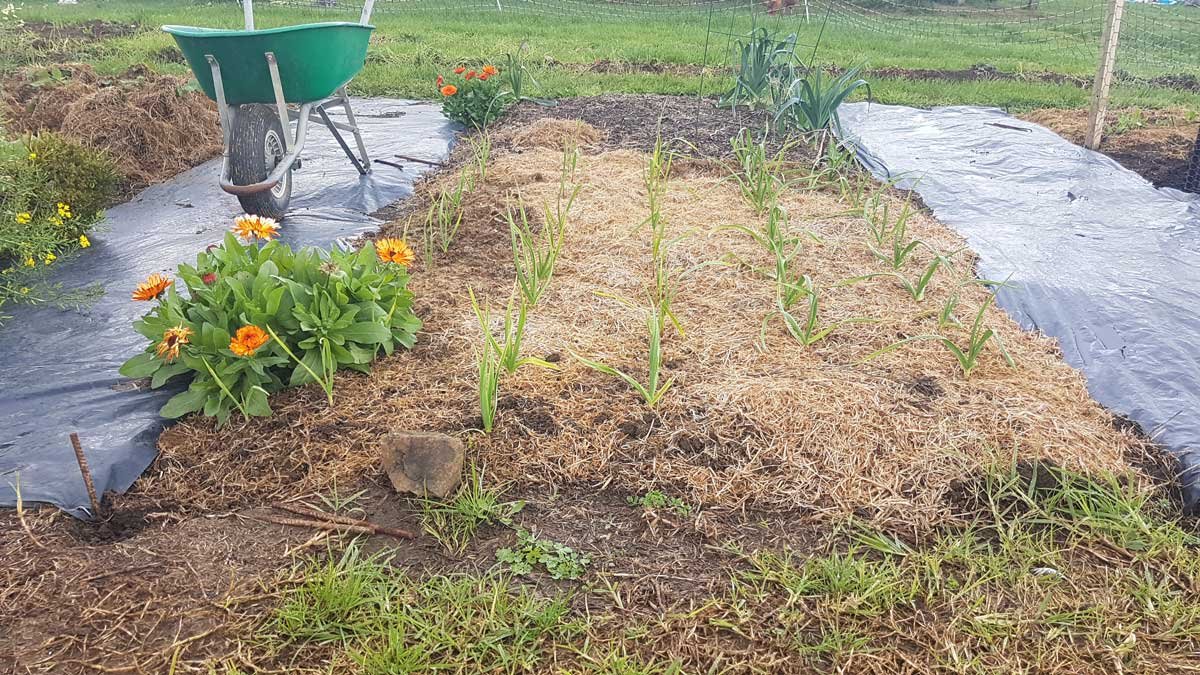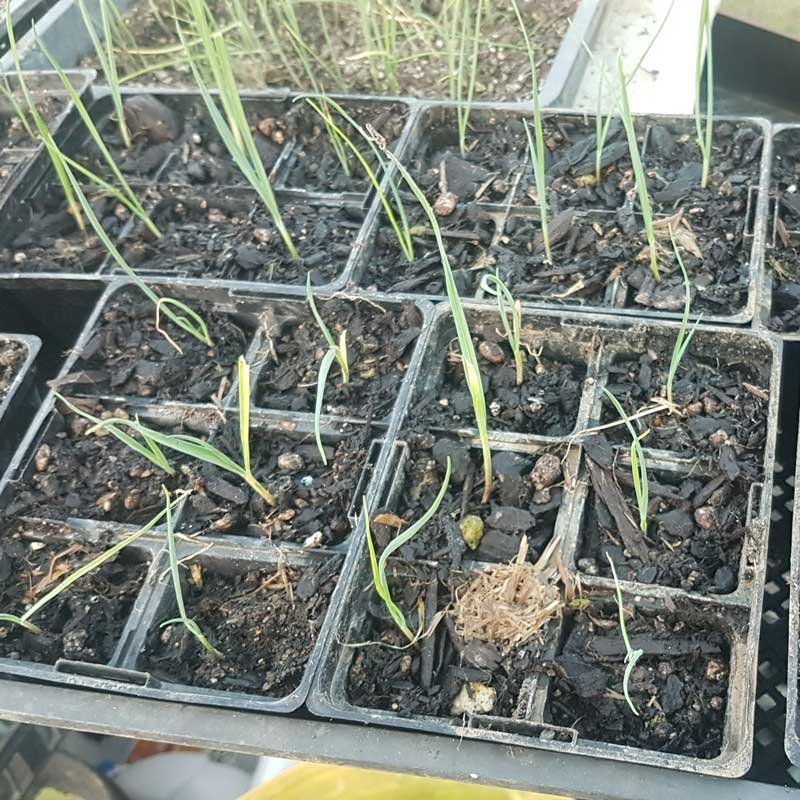One thing everyone comments on when they see my garden at the moment is the garlic. Back in May I wrote an introduction to my obsession with garlic. And since writing it, I’m beginning to see that it really is something I’m quite passionate about.
I collect heritage varieties of garlic. There’s a more in-depth introduction to them in the blog linked above. But to catch you up and without starting my usual rant, most consumers in New Zealand buy, grow, and eat one variety of garlic: Printanor. I find this garlic disappointing to grow, and a bit boring to eat.
Three years ago I fell down a rabbit hole and begun to cultivate a collection of more interesting and better performing varieties. Some grow better, some taste better, some do both. I begin with a few bulbs, and each year I save more of my best stock to grow again the year after.
The aim is to become one of the niche suppliers selling Kiwi gardeners better garlic to grow and enjoy. There’s room in the market. Every garlic supplier sells out quickly every year and I don’t think there are any in Northland (though if there are, I’d love to know about them in comments!)
The main bed
This year, the garlic bed is 3m x 6m – more than double the previous year’s footprint and over 200 plants. As well as three different varieties of true garlic (Aja Rojo, Takahue, and White Rocombole), it also contains shallots and elephant garlic. I planted it in May and it looks really great now. The leaves always suffer a bit in our garden because it’s windy, but the stalks are fattening up nicely, which is the thing I’m looking for.
Since planting, I’ve spent an hour or two with them each week. At first, rubbing out weeds as they popped up with a hoe. Then applying individual does of calcium supplements to improve their resilience against rust (only do this if you’ve done a soil test, by the way). After that there was applying a layer of compost, and a layer of grass mulch.
Now, I’m 3 months into their 6 month cycle and I have begun applying liquid fertilisers. To start, I’ve used manure-rich liquid from the duck pond. But I’ll be following that every week for the next couple of months with either seaweed/fish fertilisers, or worm juice from the worm farm.
The entire point of this blog – really – is to tell you if you’re growing garlic, it’s going to be hungry for a couple of months. Once you notice the stalks starting to fatten up, feed it so there’s lots of goodness for the bulbs underground. You’ll want to stop again about a month before harvest.
The quarantine plot
As well as the main bed, I have a smaller plot that I planted on the shortest day. I had originally told myself I didn’t need a new variety this year, but when I get bored I often haunt the gardening and agriculture categories on TradeMe. When I saw a listing for “Mongolian soft necked” garlic closing for a bargain early in the morning… well, I swooped.
But buyer beware: I’m not sure I actually got 4 bulbs of the same type of garlic. By now you might be sensing I’m a bit obsessed with garlic. And I really am. I can recognise all my varieties by sight. I’ve learned the differences and if they get mixed up somewhere during the growing, harvesting, drying, or storage processes, I’m confident I can still fix the error before they reach the consumer. Each variety grows at slightly different rates. They have different bulb sizes, growth habits, and colours. And that’s without tasting it!
But when I split the bulbs I purchased, I was fairly certain I had three different varieties. Two bulbs I suspect of being Printanor. One had yellow skin and a small number of large cloves. I think I know what it might be, but I want to see how it grows before I make a call about it. And the last bulb was one that might be described as a red soft-necked variety.
I planted around 50 cloves anyway, and recorded which bulb they came from. They’re growing quite well now. Growing them in a separate bed means they’re quarantined from the main crop in case they carry any diseases. If 2020 has taught us anything, it’s that quarantine is good for the main population. They looked fine when I planted them (and still look fine now), but I’d rather not ruin the last 3 year’s work by planting them with the main crop straight away.
The first year I grow any new variety is always a ‘test year’. Aside from potentially introducing diseases, there’s things that could go wrong. Firstly, they might not like growing in my climate. The reason I don’t grow Printanor is because I got really disappointing results. These new cloves came from Whanganui. They won’t have adjusted to our climate here in the Far North. They can adapt over time, but if I don’t have at least an OK first year, I’ll probably dump them from the collection.
I’ll be looking for uniformity to see if I have one, two, or three different varieties. I will be checking how well they do once stored. And, of course, I’ll be taste-testing them.
If they grow well with no problems, I’ll identify them and introduce them to the collection to begin expanding my seed base for future years.
Growing from bulbil
Garlic can be grown a couple of ways. Mostly, gardeners plant cloves, which grow clones. But this year I’m playing with growing bulbils, too.
Aja Rojo is a hard-necked variety that produces flowers (also called ‘scapes’). Those flowers develop hard little seed-type things called bulbils. Last year, I ended up with a couple hundred bulbils coming from these flowers. They’re a lot like seeds, but rather than having the genetic diversity of a seed, they produce a clone of the parent plant.
The main difference between bulbils and cloves is that it takes two years to get a fully developed garlic bulb from a bulbil. It takes 6 months from a clove.
I began my bulbils in a large seed tray back in April, and I’ve been lifting them out and potting them into cells this week. I’ll keep them in cells through to autumn next year, when they’ll go out into the garden somewhere. There’s about 150 of them, I think. In theory, they’ll be ready for harvest in early 2022 as full-sized garlic bulbs.
I really have no idea if this technique will work, and very little evidence to go on. It’s all an experiment. But if it does work, it’ll massively increase my stock of Aja Rojo bulbs. It’s not a bad insurance to have – collections far better than mine have been devastated by a bad year before. Collecting garlic is a bit of a gamble because you have to re-grow it each year. If I get hit by a pest or disease, it’s possible I’ll be stuck starting again.
But for now, my garlic keeps chugging away successfully, and with luck and a bit of smarts, I’m hopeful it always will. By implementing good garden hygiene, improving the soils, and constantly being curious, I’m attempting to protect against disaster. With a bit of luck on my side, I’ll be able to help everyone grow better garlic for themselves.









